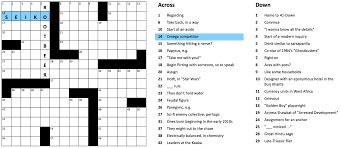Crossword puzzles have been a beloved pastime for generations, captivating the minds of word enthusiasts and casual solvers alike. Central to the intrigue and challenge of a crossword puzzle are its clues—carefully crafted hints that guide the solver toward the correct answers. But what exactly are these clues, and how do they work? Let’s explore the different types of crossword clues and the fascinating wordplay they often entail.
Definition of a Crossword Clue
A crossword clue is a hint or a series of hints that the solver must decipher to find the answer to be filled in the corresponding boxes of the puzzle grid. Unlike straightforward dictionary definitions, crossword clues can be more complex and varied, often involving puns, anagrams, homophones, and other forms of wordplay. This diversity is what makes crossword puzzles both challenging and engaging.
Types of Crossword Clues
1. Straightforward Clues
These are the most basic types of clues, providing a direct definition or synonym of the answer. For example:
- Clue: Fast (3 letters)
- Answer: RAP
2. Anagram Clues
Anagram clues indicate that the letters of the answer are scrambled within the clue itself. These clues often use words like “mixed,” “scrambled,” or “rearranged” to signal the solver. For example:
- Clue: Mixed salad ingredient (5 letters)
- Answer: RADISH (anagram of “I HAD SR”)
3. Pun Clues
Pun clues rely on wordplay, exploiting the multiple meanings of words or phrases to mislead and amuse the solver. For example:
- Clue: Tree hugger? (4 letters)
- Answer: KOALA
4. Homophone Clues
Homophone clues use words that sound alike but have different meanings and spellings. These clues often include hints like “sounds like” or “heard.” For example:
- Clue: Sounds like a barker (4 letters)
- Answer: WOOF
5. Cryptic Clues
Cryptic clues are a hallmark of British-style crosswords and involve intricate wordplay. They often contain a straightforward definition and a separate wordplay element, making them particularly challenging. For example:
- Clue: Flower of Scotland? (4 letters)
- Answer: FLOE (“flower” as in something that flows, and “Scotland?” indicating something cold or icy)
6. Double Definition Clues
Double definition clues provide two separate definitions for the same word. These clues require the solver to identify a word that fits both definitions. For example:
- Clue: State of extreme joy (6 letters)
- Answer: EXULT (where “state” refers to a condition and “extreme joy” is the definition)
7. Hidden Word Clues
In hidden word clues, the answer is hidden within the words of the clue itself, often spanning across multiple words. For example:
- Clue: A pirate’s ship captured loot (3 letters)
- Answer: ILL (hidden in “pIRate’s shIP Captured LooT”)
8. Rebus Clues
Rebus clues require solvers to enter symbols or multiple letters into a single square. These clues are often indicated by a hint in the puzzle’s instructions. For example:
- Clue: Part of a tennis match (5 letters, includes a rebus)
- Answer: SETTLE (where “SET” and “TLE” might share a square)
Crafting a Good Crossword Clue
Creating a good crossword clue involves a delicate balance of difficulty, fairness, and creativity. The clue should be challenging enough to engage the solver but fair enough to be solvable with a reasonable amount of effort. Incorporating humor, clever wordplay, and cultural references can enhance the enjoyment of solving the puzzle.
Conclusion
Crossword clues are the heart and soul of a crossword puzzle, transforming a simple grid of letters into a stimulating mental exercise. Whether through straightforward definitions or intricate wordplay, clues challenge solvers to think critically, creatively, and sometimes outside the box. Understanding the different types of clues and their mechanisms not only enhances the solving experience but also deepens appreciation for the art of crossword construction. So the next time you pick up a crossword puzzle, take a moment to savor the cleverness behind each clue, and enjoy the journey of deciphering the answers one square at a time.




